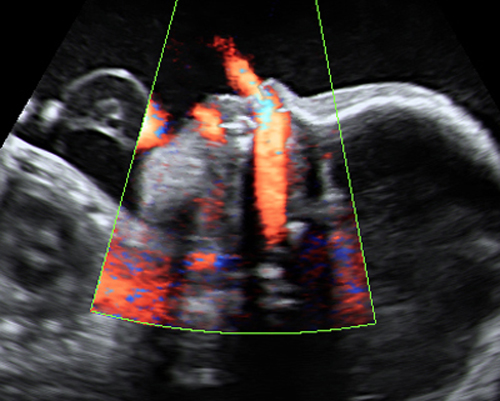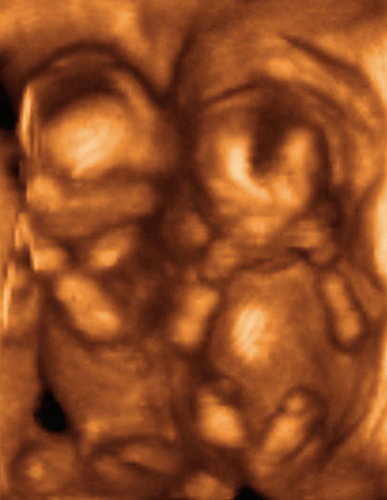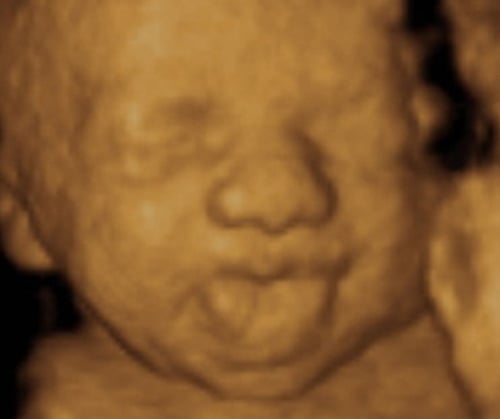You are 26 Weeks and 2 Days 96 days to go…
As the development of your baby’s eyes and sense of sight continues, he reaches another milestone: the eyelids open.
Your baby today
This color ultrasound shows the baby breathing the amniotic
fluid (red, flowing toward the ultrasound beam) in and out. The baby is
breathing a stream of fluid out through the nostrils and, at the same
time, a smaller amount through the mouth.

Although your baby’s eyelids
formed at nine weeks of pregnancy, they have remained fused together
until this week. Your baby is not in complete darkness, however, because
as the uterus grows its wall thins allowing in increasing amounts of
light. Now, your baby’s eyes have reached a stage of development where
they can open.
Even with the eyelids
open, the delicate structures of the eyeballs are protected by a fine
membrane that will completely disappear during the final month of
pregnancy.
It’s too early for your
baby to respond to light in a fully coordinated way, but he may turn
toward very strong lights or, if startled by a sudden loud noise, he
will often respond with a blink, just as children and adults do.
The retina has just
started to be lined by light-receptive rods and cones. The cones are
responsible for color vision and develop later than the more numerous
rods. The rods transmit an image in black and white and are used for
nighttime vision and for peripheral vision. Connections form between the
retina and the optic nerve, that then transmits the information it
receives to be decoded in the visual cortex at the back of the brain.
Your baby will often
bring his hands up to his face. However, because his limb movements are
now so well coordinated, he won’t touch his eyes.
… Doctor
| Q: |
I’ve got inverted nipples. Will I be able to breast-feed?
|
| A: |
Babies breast-feed rather than “nipple feed” and if your baby latches onto your breast correctly,
inverted nipples shouldn’t cause difficulties. About 10 percent of
women have flat or inverted nipples. The best way to find out whether
you can breast-feed is simply to try once your baby is born. There are
various techniques that may help: consult your doctor if you’re having
problems or contact a lactation consultant. Your doctor or hospital may
recommend one or the La Leche League can help .
|
… Twins
Growth of twins in the last trimester
In these last three months, you’re likely to get very big.
As you’d expect, the more babies inside, the greater the challenge for
your body to provide enough space as well as the perfect conditions for
growth. You’ll probably be advised to gain just under 1 lb (0.5 kg) a
week for the first half of your pregnancy and slightly more each week in
the second half.
From around 28–29
weeks, the growth of twins and other multiples slows down compared with
that of singletons. But they still move and kick as much as possible,
cushioned by amniotic fluid, which continues to increase in volume until
36 weeks.

You are 26 Weeks and 3 Days 95 days to go…
It’s a natural
instinct that parents are fiercely protective of their children, and not
unusual for this to start well before the birth.
Your baby today
Your baby sticks his tongue out often especially before or after
a particularly large gulp of amniotic fluid. Fluid doesn’t enter the
lungs but is swallowed into the stomach. Your baby would be completely
unaware of the ultrasound scan, so is not reacting to the scanner.

You may be feeling
very protective of your belly and baby. The belly almost acts as a
beacon to other people, making them aware that you’re pregnant. It’s not
unusual to feel quite vulnerable, for example in a jostling crowd or
when you’re out shopping. When this happens, make it clear to people
that you’re pregnant and, hopefully, they’ll give you more space and
give up their seat, if necessary.
When you’re driving, you
may find you’re doing so even more carefully than normal, or becoming a
very nervous or critical passenger. You may become more irritated than
usual by people who you feel are driving without concern for your
safety.
This protective
instinct is a natural part of becoming a mother. It’s the desire to
protect and nurture your child, even before yourself. Rest assured,
though, that your baby is in the safest possible environment inside your
uterus. Your body is providing your baby with warmth, food, and oxygen.
The baby is cushioned and protected by the amniotic fluid in which he
floats, and this acts as a buffer to any shoving or bumping by crowds of
people.
… Doctor
| Q: |
Why am I being told I need a glucose tolerance test?
|
| A: |
In pregnancy some women develop a form of diabetes known as gestational diabetes,
which disappears when the baby is born. It may be suspected if you have
signs such as fatigue and thirst and is confirmed by testing urine for
glucose. If it’s found, you’ll be advised to have an oral glucose
tolerance test (OGTT) between 24 and 28 weeks. You’ll be tested earlier
if you have a BMI over 35, a close relative with diabetes, or had
diabetes in a previous pregnancy.
|
HypnoBirthing
The idea of
hypnoBirthing—giving birth in such a relaxed state that you barely feel
pain—sounds too good to be true. But the research extolling its benefits
is impressive. Several studies have shown that self-hypnosis helps
women feel less anxious about labor and birth. They also tend to require
minimal pain relief and medical intervention: many women succeed in
giving birth at home.
HypnoBirthing is a great idea
but it’s important that you are taught the various relaxation and
visualization techniques and practice them regularly during pregnancy.

You learn a series of self-hypnosis,
relaxation, visualization, and breathing techniques, which over time
become second nature, enabling you to approach childbirth in a calm,
positive frame of mind.
By practicing hypnoBirthing, you should feel in control of your body and able to manage the pain during labor and delivery.
The key is to practice frequently, and a supportive birth partner is invaluable for helping you perfect the techniques, and use them in labor.